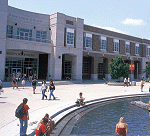2008 Campus Technology Innovators: Social Networking for Admissions

CLUBRED ENABLES incoming UNL freshmen to interact and form connections with peers-- before they arrive on campus.
TECHNOLOGY AREA: SOCIAL NETWORKING FOR ADMISSIONS
Innovator: University of Nebraska-Lincoln
Working with applicants and admittees in their own milieu of social networking, one university is so successful, its enrollees end up recruiting new candidates.
In the world of Web 2.0, social networking is paramount. It stands to reason, then, that a brand-new social networking effort at the University of Nebraska-Lincoln would attract quite a bit of attention from students and faculty members alike.
The effort, called ClubRed, essentially is a private social network for admitted University of Nebraska undergrads. Before these students ever arrive on campus, they can set up profiles and upload photos, search for friends, check and send messages, join discussions, and read and comment on blogs-- all within ClubRed. Students also can review their personalized Office of Admissions checklist for preparing to enroll.
According to project lead Adam Stahr, senior admissions counselor, the most significant aspect of the network is its integration with a customer relationship management (CRM) solution from Talisma, which allows for personalized "marketing" messages to each student, based on that student's position in the admissions process.
"The integration of our private social network with our CRM technology results in an extremely powerful and more easily leveraged recruitment tool," says Stahr. "It's made us more responsive and receptive to the needs of our prospective students."
The effort began in the summer of 2007. After the university's freshman class grew by a total of 1,000 students in three years, admissions officers set out to find a way to improve admitted student yield and embrace the online communication style of today's teenagers. After considering tools from Ning and the option of building their own social networking technology in-house, technologists opted to go with the U360 social networking product from Straxis.
Already, 75 percent of ClubRed users have submitted an enrollment deposit, signaling that the technology is building loyalty among its users.
Later, with the help of a homegrown front-end application processing system that interfaces directly with the school's student information system, technologists facilitated the quick exchange of data across systems. The homegrown tool, NUView (not to be confused with the commercial solution by the same name), provides application, enrollment deposit, and orientation information to Talisma on a nightly basis, enabling ClubRed to interface with the CRM tools daily.
Results have been overwhelmingly positive. Only 24 hours after ClubRed's launch this past January, 350 students had already logged in and created profiles. As of May 15, the network boasted more than 1,400 users who had logged in an average of 18.4 times over the past two months. In most cases, incoming freshmen have interacted and formed connections with their peers-- all before the first day of school. Stahr says that prospective students are now recruiting one another, simply by talking about ClubRed and raising awareness of the university's commitment to superior technology.
Staff members seem to be embracing ClubRed as well. Stahr notes that in the first two weeks, many staff members actually found it difficult to log off, even outside of office hours. Additional benefits are even more significant: Already, 75 percent of ClubRed users have submitted an enrollment deposit-- signaling that the technology is building loyalty among its users almost instantaneously. According to Stahr, ClubRed gives the University of Nebraska-Lincoln an immediate competitive edge over institutions that have not yet developed a private social network or have not yet explored the integration of a campus CRM system with an existing social network. University officials expect that, over time, ClubRed will have a positive impact not only on admitted student yield rates, but also on freshman-to-sophomore-year retention rates.
Currently, only high school seniors have been given access to ClubRed. Stahr explains that the next step is to allow admitted transfer and international students to access the network so that they might be able to connect with their future classmates. In addition, the school recently embarked on an effort to improve and expand upon ClubRed's current capabilities and attract students who have yet to log in.